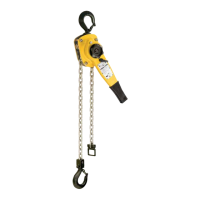4
F
tion is visual and functional. This inspection
shall establish that the unit is safe and has
not been damaged by incorrect transport or
storage. Inspections should be madeby are-
presentative of the manufactureror the supp-
lier although the company can assign its own
suitablytrained personnel.
INSPECTIONBEFORESTARTINGWORK
Beforestartingworkinspectthe hoist, chain(s)
and all load bearing constructions every time
for visual defects. Furthermore test the brake
and make sure that the load and hoist are
correctly attached. For this purpose a short
work cycle of lifting/pulling or tensioning and
releasingshouldbe carried out.
Loadchain inspection
Inspect the load chain for sufficient lubrica-
tion and visually check for external defects,
deformations, superficial cracks, wear or cor-
rosionmarks.
Chain stop inspection
The chain stop must be connected to the free
(idle) chain strand (Fig.11).
Inspection of top and bottom hooks
Inspect top and bottom hooks for deforma-
tions, damage, cracks, wear or corrosion
marks.
Chain reeving inspection
All units equipped with two or more chain falls
should be inspected prior to being put into
operation for twisted or kinked chains. The
chains of multiple fall hoists may be twisted if
the bottom block was turned over (Fig. 9).
The load chain has to be installed according
to illustration (Fig. 10). Hereby the welds on
the standing links must face away from the
load sheave.
FUNCTION / OPERATION
Free chaining device
Turn pawl rod lever (Fig. 11) to neutral (cen-
tral) position. Thechain cannow be pulled in
both directions and the bottom hook will be
quicklybroughtto the requiredposition.
Warning: The minimum load to engage the
automaticbrakeliesbetween30 -45kg.
Liftingthe load
Turn pawl rod lever to the lifting position , ’
(Fig. 11). Operate hand lever with a pumping
action. If work is stopped while the hoist is
under load, the pawlrodlevermustremainin
the lifting position, ’.
Français
INTRODUCTION
Tousles utilisateurs doivent lire attentivement
les instructions de mise en service avant la
1
ère
utilisation. Ces instructions doivent
permettreà l’utilisateur de se familiariser avec
le palan et de l’utiliser au maximum de ses
capacités. Les instructions de miseen service
contiennent des informations importantes sur
la manière d’utiliser le palan de façon sûre,
correcteet économique.Agirconformément à
ces instructions permet d’éviter les dangers,
réduire les coûts de réparation, réduire les
temps d’arrêt et augmenter la fiabilité et la
duréede viedu palan.Le manueld’instruction
doit toujours être disponible sur le lieu
d’utilisation du palan. En complément des
instructions de mise en service et des
réglementations relatives à la prévention des
accidents, il faut tenir compte des règles en
vigueur en matière de sécurité du travail et
professionnellesdans chaquepays.
UTILISATION CORRECTE
- Le palan a été conçu pour lever, tirer ou
mainteniren tensiondes charges.
- L’appareil de levagepeut donc êtreutilisé pour
arrimerdeschargessurun camion.Pourcela,
il estindispensablede se référer auxvaleurs
(indiquées sur la plaque constructeur) de
l’effort minimum à appliquer manuellement
sur le levier ainsi que de l’effort de tension
maximalsupportépar la chaînede charge.
- La capacité indiquéesurle palancorrespond
à la capacité maximaled’utilisation (C.M.U.);
celle-ci ne doiten aucuncasêtre dépassée.
- La charge et le crochet de suspension du
palandurantles opérationsde levagedoivent
être perpendiculaire au centre de gravité de
la charge afin d’éviter toute oscillation de la
charge(cf. fig.1).
- Ne pasautoriserle personnel à passersous
une chargesuspendue.
- Ne pas laisser la charge suspendue ou en
tensionsans surveillance.
- Ne commencer à manœuvrer la charge
qu’après l’avoir suspendue correctement et
s’être assuré que tout le personnel est sorti
de la zonede danger.
- L’opérateur doit s’assurer que la charge est
suspenduede manière à ce quele palan, la
chaîne et la charge ne le mettent pas en
danger,luiou d’autres personnes.
- Les palans peuventêtremanipulésdansdes
températuresambiantescomprisesentre
– 10 C et + 50 C. Veuillez consulter le
fabricant en cas de conditions extrêmes
d’utilisation.
Theloadmust alwaysbe seated in the saddle
of the hook.Neverattachthe loadon the tip of
the hook. This also applies to the top hook
(Fig.8).
Lowering the load
Turn pawl lever to the lowering position , ’
(Fig. 11). Operate hand lever with a pumping
action.
Brake jamming
lf a hoist, which is under load, is suddenly
relievedof loadpressure,e.g.by lifting off the
loador whenpullingdownwalls,the brake will
remain locked. Thebrake will also lock if the
bottom block is pulled too tightly against the
housing.
Releasing thejammed brake
Turn pawl rod lever to lowering position , ’.
Operate hand lever with a vigorous stroke. lf
the brakeis jammed on extremelytight, it can
be released by striking hand lever, ensuring
pawlrodleveris in the lowering, ’ position.
INSPECTION /MAINTENANCE
To ensurethat the hoists remain in safework-
ing order they are to be subjected to regular
inspections by a competent person. Inspec-
tions areto be annual unlessadverseworking
conditions dictate shorter periods. The com-
ponents of the hoist are to be inspected for
damage, wear, corrosion or other irregulari-
ties and all safety devices are to be checked
for completeness and effectiveness. To test
the brake, a test load of the hoist’s rated ca-
pacity is required. To check for worn parts it
maybe necessaryto disassemblethehoist.
Repairs may only be carried out by a
specialist workshop that uses original
Yalespare parts.
Inspections are instigated by the user.

